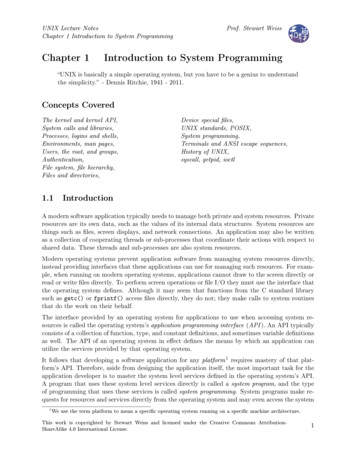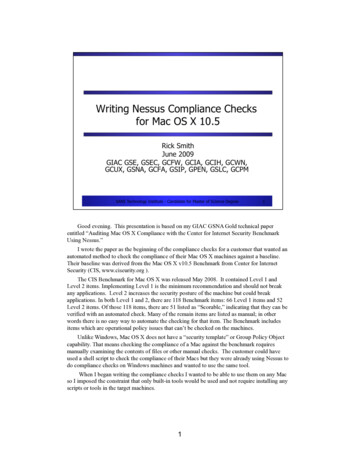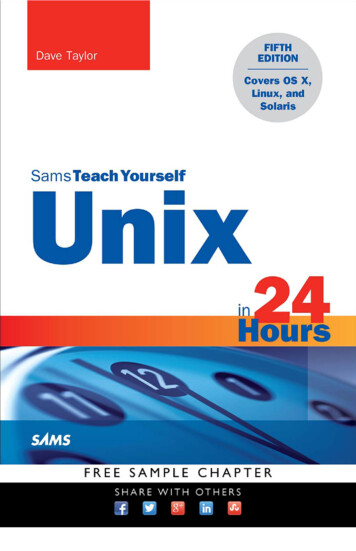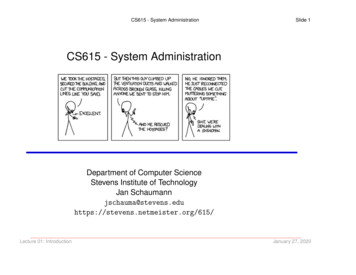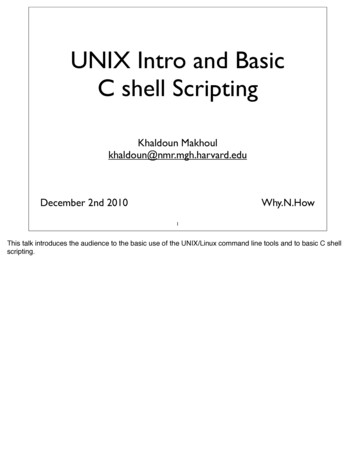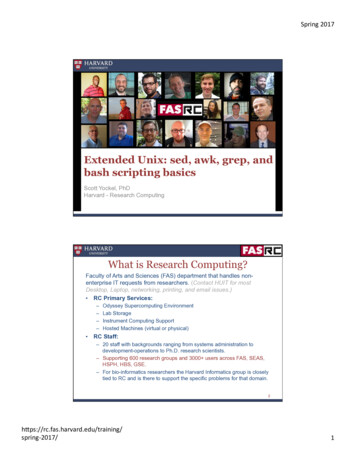
Transcription
Spring 2017Extended Unix: sed, awk, grep, andbash scripting basicsScott Yockel, PhDHarvard - Research ComputingWhat is Research Computing?Faculty of Arts and Sciences (FAS) department that handles nonenterprise IT requests from researchers. (Contact HUIT for mostDesktop, Laptop, networking, printing, and email issues.) RC Primary Services:–––– Odyssey Supercomputing EnvironmentLab StorageInstrument Computing SupportHosted Machines (virtual or physical)RC Staff:– 20 staff with backgrounds ranging from systems administration todevelopment-operations to Ph.D. research scientists.– Supporting 600 research groups and 3000 users across FAS, SEAS,HSPH, HBS, GSE.– For bio-informatics researchers the Harvard Informatics group is closelytied to RC and is there to support the specific problems for that 2017/1
Spring 2017FAS Research Computinghttps://rc.fas.harvard.eduIntro to OdysseyThursday, February 2nd 11:00AM – 12:00PM NWL 426Intro to UnixThursday, February 16th 11:00AM – 12:00PM NWL 426Extended UnixThursday, March 2nd 11:00AM – 12:00PM NWL 426FAS Research Computing will be offering a SpringTraining series beginning February 2nd. This series willinclude topics ranging from our Intro to Odysseytraining to more advanced job and software topics.Modules and SoftwareThursday, March 16th11:00AM – 12:00PM NWL 426In addition to training sessions, FASRC has a largeoffering of self-help documentation athttps://rc.fas.harvard.edu.Choosing Resources WiselyThursday, March 30th11:00AM – 12:00PM NWL 426We also hold office hours every Wednesday from12:00PM-3:00PM at 38 Oxford, Room shooting JobsThursday, April 6th 11:00AM – 12:00PM NWL 426For other questions or issues, please submit a ticket onthe FASRC Portal https://portal.rc.fas.harvard.eduOr, for shorter questions, chat with us on Odybothttps://odybot.rc.fas.harvard.eduParallel Job Workflows on OdysseyThursday, April 20th 11:00AM – 12:00PM NWL 426Registration not required — limited harvard.edu/training/spring-2017/2
Spring 2017Unix Command-Line Basics Understanding the Terminal and Command-line: STDIN, STDOUT, STDERR, env, ssh, exit, man, clear Working with files/directories: ls, mkdir, rmdir, cd, pwd, cp, rm, mv scp, rsync, SFTP Viewing files contents: less Searching with REGEXP – stdin/files: * Basic Linux System Commands: which5Objectives Unix commands for searching––––REGEXgrepsedawk Bash scripting basics– variable assignment integers strings arrays– for 17/3
Spring 2017REGEX - Regular Expression Pattern matching for a certain amount of text– Single character: O Odybot isn’t human– Character sets: [a-z] Odybot isn’t human– Character sets: [aei] Odybot isn’t human– Character sets: [0-9] Odybot isn’t human– Non printable characters \t : tab\r : carriage return\n : new line (Unix)\r\n : new line (Windows)\s : space7REGEX - Regular Expression Pattern matching for a certain amount of text– Special Characters . period or dot: match any character (except new line)\ backslash: make next character literal caret: matches at the start of the line dollar sign: matches at the end of line* asterisk or star: repeat match? question mark: preceding character is optional plus sign:( ) parentheses: create a capturing group[ ] square bracket: sequence of characters– also seen like [[:name:]] or [[.az.]] { } curly brace: place bounds– 17/4
Spring 2017grep - GNU REGEX Parser grep is a line by line parser of stdin and by defaultdisplays matching lines to the regex pattern. syntax:– using stdin: cat file grep pattern– using files: grep pattern file common options:––––––c : count the number of occurrencesm # : repeat match # timesR : recursively through directorieso : only print matching part of linen : print the line numberv : invert match, print non-matching lines9sed - stream editor sed takes a stream of stdin and pattern matches andreturns to stdout the replaced text.– Think amped-up Windows Find & Replace. syntax:– using stdin: cat file sed ‘command’– using files: sed ‘command’ file– common uses: 4d : delete line 42,4d : delete lines 2-42w foo : write line 2 to file foo/here/d : delete line matching here/here/,/there/d : delete lines matching here to theres/pattern/text/ : switch text matching patterns/pattern/text/g: switch text matching pattern globally/pattern/a\text : append line with text after matching pattern/pattern/c\text : change line with text for matching 017/105
Spring 2017sed - Examples Take the time to create abc.txt file below and try out qrstuvwxyzsed ‘2,4d’ abc.txtsed ‘s/abc/123/’ 11Objectives Unix commands for searching––––REGEXgrepsedawk Bash scripting basics– variable assignment integers strings arrays– for 017/6
Spring 2017awk command/script language that turns text into records and fieldswhich can be selected to display as kind of an ad hoc database.With awk you can perform many manipulations to these fields orrecords before they are displayed. syntax:– using stdin: cat file awk ‘command’– using files: awk ‘command’ file concepts:– Fields: fields are separated by white space, or by regex FS. The fields are denoted 1, 2, ., while 0 refers to the entire line. If FS is null, the input line is split into one field per character.– Records: records are separated by \n (new line), or by regex RS.13awk A pattern-action statement has the form:pattern {action} A missing {action} means print the lineA missing pattern always matches. Pattern-action statements are separated by newlines or semicolons.There are three separate action blocks:BEGIN {action}{action}END g-2017/7
Spring 2017Simple awk examplealpha.txtawk ‘{print 1}’ alpha.txtawk ‘{print 1, 3}’ alpha.txtalpha beta gammadelta epsilon phialphadeltaalpha gammadelta phi15awk - built in variables The awk program has some internal environment variables that areuseful (more exist and change upon platform)– NF – number of fields in the current record– NR – ordinal number of the current record– FS – regular expression used to separate fields; also settable by option -Ffs(default whitespace)– RS – input record separator (default newline)– OFS – output field separator (default blank)– ORS – output record separator (default newline)alpha beta gammadelta epsilon phiawk '{OFS ",";print 1, 3}' alpha.txtawk -Fa ‘{print 2}' alpha.txtalpha,gammadelta,philphepsilon 7/8
Spring 2017awk - statements An action is a sequence of statements. A statement can be one ofthe following:–––––if (expression) statement [ else statement ]while (expression) statementfor (expression ; expression ; expression) statementfor (var in array) statementdo statement while (expression)alpha beta gammadelta epsilon phiawk '{if (NR 1) print 2}' alpha.txtawk '{if ( 1 "alpha") print}' alpha.txtepsilonalpha beta gamma17awk - variables Using variables:– You can use the stock 1, 2, 3, fields and set them to variables in the actionblock.alpha beta gammadelta epsilon phiawk '{if (NR 1) a 1; else b 1}END{print a, b}' alpha.txtalpha deltaawk '{if ( 1 "alpha") a 123; else b 456}END{print a " " b}' alpha.txt123 456awk '{if ( 1 "[a-z]") ; sum 1}END{print "Total: " sum}' alpha.txtTotal: 9
Spring 2017awk - mathematicsThe operators in AWK, addition, - subtraction, * multiplication, / division, and % modulus.Assignment - * / % . Both absolute assignment (var value) and operator-assignment(the other forms) are supported.Trigonomic function: cos(), sin(),Roots: sqrt()19awk - formatted printing awk accepts all standard printf statements syntax: printf(“format”,expression list)ps S -o pid,nlwp,%mem,rss,vsz,%cpu,cputime,args --forest -u USER \awk '{pmem 3;rss 4;vsz 5; print 0}END{printf("MEM SUM:%4.1f%% %3.1fGB %3.1fGB \n", pmem,rss/1028/1028,vsz/1024/1024)}'PID NLWP %MEM275361 0.0275481 0.0229051 0.0229081 0.0229091 0.0265701 0.0265871 0.0248311 0.0MEM SUM:0.0%RSSVSZ %CPU2052 99920 0.02044 120932 0.31252 106100 0.01156 122668 6.0896 105956 0.02008 99920 0.02052 120932 0.05088 149524 0.00.0GB 0.9GBTIME COMMAND00:00:00 sshd: syockel@pts/8600:00:00 \ -bash00:00:00\ /bin/bash ./ps.sh00:00:00\ ps S -o pid,nlwp,00:00:00\ awk {pmem 3;rss00:00:00 sshd: syockel@pts/8100:00:00 \ -bash00:00:00\ vim user chk.shprintf created END 17/10
Spring 2017Objectives Unix commands for searching––––REGEXgrepsedawk Bash scripting basics– variable assignment integers strings arrays– for loops21Shell Script Basics To take advantage of cluster compute, you can predefine yourcommands in a shell script file to be executed by a job scheduler.– bash: bourne again shell– csh: c-like shell– zsh: shell for modern times#!/bin/bash# Setting varsvar1 input.txtdir1 test.dsha-bang line defines the shell# defines comments the remain line outAssign variables using “ “ as either string or integer# Executing commandsecho “Var 1 is set to: var1”cd dir1pwdUse a variable with “ 7/11
Spring 2017Shell Script Basics If string contains whitespace, it must be included in double quotes.#!/bin/bash# Setting varsvar1 “1.txt 2.txt 3.txt 4.txt”# For loopfor i in var1 ; doecho idonestring variablelooping through each element in the string23Shell Script Basics Bash allows array variables#!/bin/bashj 0for i in {01.05} ; doj ((j 1))alpha[ j] iecho {alpha[*]}done{ } defines a rangeincrement juse j to index alpha arrayprint all elements of alpha 017/12
Spring 2017Questions ?Scott Yockel, PhDHarvard - Research -2017/SIGHPC: BigDataSupercomputing’1613
Unix commands for searching – REGEX – grep – sed – awk Bash scripting basics – variable assignment integers strings arrays – for loops 21 Shell Script Basics To take advantage


